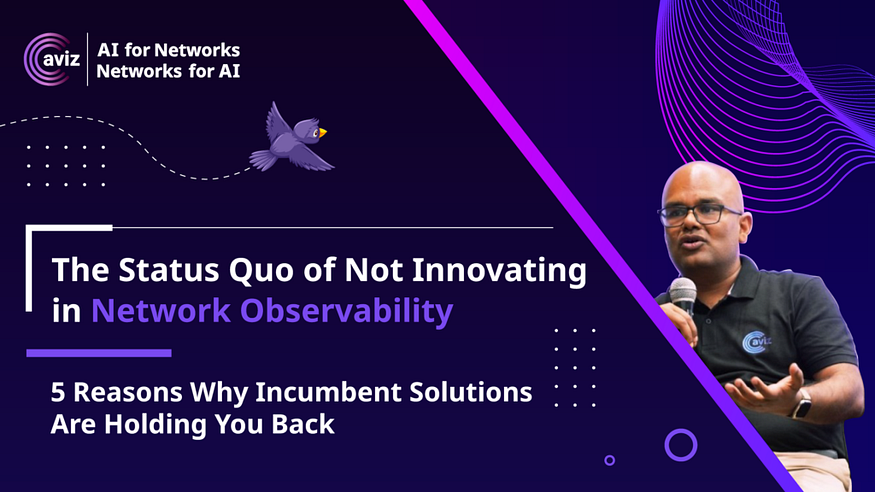The Status Quo of Not Innovating in Network Observability: 5 Reasons Why Incumbent Solutions Are Holding You Back

Network observability is the lifeline of any modern digital infrastructure. Yet, for a space that’s so critical, it’s stuck in time. While the rest of the tech world is sprinting forward — driven by AI, cloud-native models, and vendor-neutral strategies — network observability is still clinging to a status quo that’s not just outdated, but actively limiting.
Let’s break it down. Here are five reasons why incumbent network observability solutions are failing us:
1. Still Hardware-First in a Software-First World
In nearly every part of the infrastructure stack — from storage to compute to networking — we’ve seen a clear shift: software first, hardware second. Flexibility, scalability, and rapid innovation are made possible by decoupling software from rigid, proprietary hardware.
Yet, most legacy network observability solutions still demand specialized boxes and appliances. Want to scale? Add more hardware. Want to adapt quickly? Sorry, you’re locked into a lifecycle that moves at the speed of hardware refreshes.
2. FPGA-Based Inspection in the Age of Commodity Hardware
Let’s be honest — specialized hardware like FPGAs made sense once. But that was before we had powerful CPUs, DPDK, and smart NICs. While the rest of the world moved to commodity hardware, incumbents are still selling FPGA-based packet brokers and inspection tools like it’s 2010.
It’s expensive. It’s rigid. It’s power-hungry. And it’s not necessary anymore.
3. Zero Interoperability — The Multi-Vendor Wall
You’d think by now, standardization would be a given in a mature space like this. But no — every legacy vendor still pushes their own closed ecosystem. Want to mix vendors or tools? Good luck. You’ll need custom integrations, proprietary interfaces, and a whole lot of patience.
This kind of lock-in doesn’t just slow you down — it kills your ability to innovate and optimize.
4. Outdated Pricing Models
Imagine paying per port, per chassis, or per feature toggle in 2025. That’s what you’re still doing with many observability vendors.
Modern infrastructure is elastic. Pricing should be too. But these old-school models bleed your budget dry and offer zero alignment with actual usage or value.
5. No AI, No Intelligence
Perhaps the most glaring sign of the status quo? A complete absence of AI built for network observability. While enterprises apply AI to observability, automation, and security — observability tools are still glorified packet movers.
There’s no intelligence to connect insights in real-time, correlate across layers, or surface actionable anomalies. And in a world of LLMs, that’s just inexcusable.
So, What’s the Alternative? Meet Aviz.
At Aviz, we’ve reimagined what network observability should look like. Our Network Observability Portfolio is built for this new era:
- Multi-vendor packet broker: Works across four different vendors out of the box. No lock-in, no silos.
- Runs on CPUs, not FPGAs: Thanks to DPDK, our service nodes don’t need specialized hardware.
- Accelerates with NVIDIA BlueField: Need more performance? Drop in a BlueField DPU — our platform scales up intelligently.
- AI-Connected Observability with TestWork Copilot: Our observability stack isn’t just passive. It connects with the rest of your network in real time, using AI to bridge data, tools, and action.
And This Isn’t Just Theory.
A major telco deployed our solution in the capital region of one of the biggest economies in the world, serving 30 million subscribers. Data is processed with 5-second granularity, enabling precise, real-time insights.
Results?
- 80% reduction in hardware footprint — saving on capex, power, and data center space
- 50% reduction in operational expense — thanks to intelligent, standardized tooling
Why? Because we broke the status quo. Because we standardized the observability layer. Because we believe that network observability deserves innovation too.
FAQ’s
1. Why are legacy network observability tools considered outdated in today’s infrastructure?
Legacy tools rely on hardware-first approaches, proprietary FPGAs, and rigid pricing models that don’t align with today’s software-first, AI-driven, and multi-vendor ecosystems — making them costly, inflexible, and slow to evolve.
2. What’s wrong with FPGA-based packet brokers for network observability?
While once necessary, FPGA-based tools are now power-hungry, expensive, and unnecessary. Modern observability can be powered by software-defined solutions running on commodity CPUs or smart NICs, offering better flexibility and scalability.
3. How does vendor lock-in impact network observability performance?
Vendor lock-in limits interoperability, slows innovation, and prevents IT teams from integrating best-of-breed solutions — leading to inefficiencies, higher costs, and reduced agility across observability and analytics workflows.
4. How is Aviz redefining modern network observability?
Aviz offers an open, AI-connected observability stack that supports multi-vendor environments, runs on commodity CPUs (or NVIDIA BlueField DPUs when needed), and integrates TestWork Copilot for intelligent, real-time insights — no lock-in required.
5. What real-world benefits does Aviz Observability deliver over traditional solutions?
A major telco using Aviz achieved:
- 80% reduction in hardware footprint
- 50% drop in operational costs
- 5-second telemetry granularity
These results were possible due to standardization, CPU-based design, and AI-connected observability.


Comments
Post a Comment